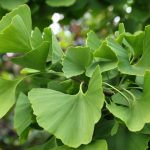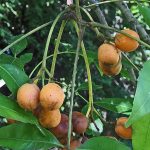TREE LIFE
JANUARY 2018
Mashonaland Calendar
The Tree Society Committee would like to wish members a very happy 2018. We look forward to positive change.
Saturday January 6th: Botanic Garden Walk. Meet in the car park for an 8.30am start. The gardens will be looking good after the rains and there will be much to see.
Sunday January 21st: Outing to Mbizi Game Park (weather permitting). Mbizi is near the airport, just the other side of the dam from Chedgelow where we have had such good botanising in the past. If the rain continues between now and then there should also be wonderful fungi to see. Meet at Mukuvisi car park at 9.15am for those wanting to share transport or at Mbizi at 9.45am. Bring a picnic, chairs etc. and come to enjoy a really good day out.
Saturday January 27th: Mukuvisi Woodlands. Meet at the Blatherwick Gate, Mukuvisi Woodlands at 14.30 hours. Please be on time so that we can lock the gate behind us. There will be plenty of interest if this lovely rain continues, including fungi.
Tree Of The Month
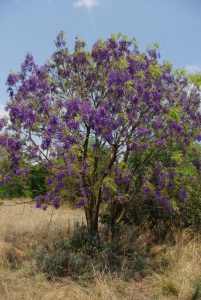
Bolosanthus speciosus
Family Leguminoseae, sub-family Papilionoideae. Common names: Tree Wisteria; mukwashanyama (S); impaca (N).
The generic name Bolusanthus honours Harry Bolus (1834 to 1911) who was a South African botanist and founder of the Cape Town Bolus Herbarium (at UCT), while the specific name speciosus means beautiful or showy in Latin.
This is my favourite of all indigenous trees. It is a highly decorative, relatively small tree of usually only four to seven metres in height that is naturally widespread in wooded grasslands at medium and low altitudes in Southern Africa, ranging from Angola and Zambia down to KwaZulu Natal.
It is a graceful tree that makes an excellent garden subject and which, in the right sunny spot with good well-drained soil, grows well in Harare. It can also be grown in a container and looks spectacular on any sunny patio.
The Tree Wisteria is the only species in the genus Bolusanthus (= monospecific) and is a protected species in South Africa. The multi-stemmed tree is briefly deciduous, dropping its leaves for only a short time in early spring.
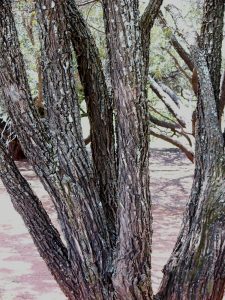
bolosanthus speciosus trunk
The trunk is eye-catching – blackish brown, rough and deeply longitudinally fissured – and the delicate, bright shiny green compound leaves are suspended from drooping branches. The leaflets have a conspicuous pale yellowish midrib and a narrow, tapering point.
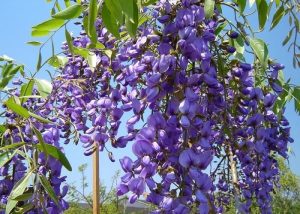
Bolosanthus speciosus flowers
The pea-shaped flowers (typical of the Papillionoideae) are a striking bluish-mauve, growing in drooping, loose terminal sprays that often cover the whole tree. They appear in spring (August to October) but can extend into November and December, even into January in some years.
Flowers are followed by brown pods, typical of legumes, that are papery and may be indehiscent or only split open in February or March.
The straight stems are hard, termite resistant and so can be used for fence posts. The wood is one of the best and hardest of indigenous timbers, which makes it sought-after by carpenters. Although usually making only small wood items, has a wide variety of uses including furniture and lampshades, as well as bowls and other articles produced on the lathe. The roots are used medicinally to alleviate stomach problems and the inner bark used to treat abdominal cramps. Animals including monkeys, gemsbok, giraffe and grey duiker eat the pods and leaves.
Sources:
Coates-Palgrave, K. 1977. Trees of Southern Africa. Struik, Cape Town.
Grow Wild: Bolosanthus speciosus. www.growwild.co.za
Klapwijk, N. 2003. Bolusanthus speciosus. PlantzAfrica. Sourced 6th December 2017. https://pza.sanbi.org/bolusanthus-speciosus
PlantBook South Africa: Bolosanthus speciosus. https://www.plantbook.co.za/wp-content/uploads/plantbook.co.za_bolusanthus-speciosus8.jpg
Wikimedia: Bolosanthus speciosus stem. www.wikimedia.org
Isla Grundy
[As there were no outings in December 2017 apart from the Christmas party (which sadly this year was a little thin on the ground), here are some articles taken from past copies of Tree Life that Mary has been so heroically retyping. The following three are from 1987, and remind us that one of the important aspects of the Tree Society is education – learning about the biology and importance of trees. With our woodland fast disappearing as we speak, should one of our New Year resolutions not be to focus more on the formal educational aspects of the Society once again?
Ed]
Taken from Tree Life 92, October 1987
Botanic Garden Walk Tuesday 1st September
Unfortunately Tom was not able to get back from a trip to Banket in time for the walk on 1st September but fortunately Kim had returned from his trip to the Valley. A Fernandoa magnifica was in flower and he took the opportunity to talk both about the flowers and the family BIGNONIACEAE.
The family is mostly tropical and consists mainly of woody species many of which are lianas. They usually have large showy flowers and compound leaves with a single leaflet at the end – imparipinnate. The leaves are usually opposite, an unusual feature for compound leaves and therefore a diagnostic feature for the family. The leaves can also be in whorls of three.
We are well acquainted with members of the family, BIGNONIACEAE. The exotic species which are familiar to all of us in Harare are:
- Jacaranda – Jacaranda mimosifolia from Brazil;
- Spathodea – Spathodea campanulata from Kenya and Tanzania;
- Tabebuia – Tabebuia serratifolia from tropical and south America, with yellow flowers and Tabebuia rosea with white to deep pink flowers from South Africa;
- Tecomaria – Tecomaria capensis, the Cape Honeysuckle with orange to red flowers.
We started by looking at the flowers of Fernandoa. These are about 8 cm in diameter, bright orange to crimson with a yellow centre. They are bat pollinated and we were told that, as this required lots of energy, the flowers produce vast quantities of nectar. This proved to be true and we could see the nectar running down the petals.
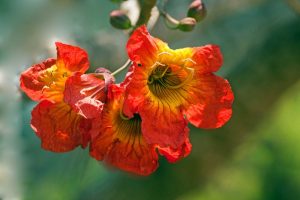
Fernandoa flower
When there are five sepals and five petals there should be five to 10 anthers but there were only 4 on the flowers we were looking at, the fifth had become vestigial and is therefore called a staminode. The flower also has bi-lateral symmetry and this is an indication that it is a flower of an advanced family. More primitive flowers have a radial symmetry. The anthers are fused to the petals so that, after pollination, when the petals fall the anthers are also discarded. Which prompted Kim to remind us that, in nature, the male is often an ecological luxury. The stigma, style and ovary are left behind and the pollen grows down the small style until it reaches the ovary and fertilisation takes place.
The sausage tree Kigelia africana bears its flowers on long thin stalks. The flowers are bat pollinated and therefore pollinated in the early evening or at night and in order to ensure that pollination takes place the trees produce a large number of flowers. We counted over 50 buds on one stalk, which certainly did not seem capable of bearing that number of sausages. The Sausage Tree probably overcomes the problem by sending a message to the other flowers to abort as soon as one of them has been fertilised. Occasionally it happens that two flowers on a stem are fertilised at about the same time, and so two fruits grow from the same point.
Most of the members of BIGNONIACEAE bear pods like the Markhamia. Inside, these can have a partition down the centre which splits the pod in two and the seeds are usually winged. Both these characteristics differentiate them from the pods and seeds of the legumes.
Other indigenous members of the family are Stereospermum kunthianum, the Pink Jacaranda, which should be flowering in September on the Escarpment and in the Zambezi Valley. For those who are not able to travel that far there is one in the grounds of Species College in Rhodes Avenue (now Herbert Chitepo) and one in the Main Park just south of the Kiosk. And in the south of the country the Rhigozum should be in bright yellow flower in October.
Thank you Kim for fascinating us with the lore of flowers and for doing so without any warning that you would be called upon to conduct the walk.
Meg Coates Palgrave
Photo: Fernandoa magnifica https://www.westafricanplants.senckenberg.de/images/pictures/fernandoa_magnifica_mwestrop_6331594110_o_3242_727525.jpg
The 37th Agm Held At Spey Bey, Ruwa, Sunday 17th May 1987
We are indeed indebted to Mrs. Teunon for allowing us to invade her beautiful garden, which proved to be a superb setting for the AGM.
Chairman’s Report
It is 14 months since the last AGM on the lawns of Gletwyn. During these months the Society has been so active that it has been difficult keeping a record to send out with the newsletters, and often my other responsibilities have been neglected. As a chairman I have welcomed the ever-greater workload which the committee has accepted, particularly in connection with the newsletter. Every member of the committee has been inveigled into playing some role along the line and so on behalf of the Society I offer my thanks to them all. Expressing our gratitude to the typists at Duplicating Services is long overdue. Their welcoming office has the happiest of memories, which are naturally coloured by the fact that, at that stage, the newsletter has finally been written and my role is over for another month. When Vida took over as Membership Secretary my workload was reduced even further and this role is now performed with greater efficiency than before. The committee’s teamwork has been so well coordinated it is not practical to enumerate the virtues of the individual members, but their continued support through a difficult year has been gratefully appreciated.
So what has the Society achieved and in what direction are we now facing? In the past year we have increased our familiarity with the Zambezi Valley. In April 1986 when I was rained in at A-camp while teaching for the Mashonaland Hunter’s Association, an energetic party, that included Bob Drummond from the Herbarium, set off by boat from Chirundu to Ruchomechi. The knowledge gained from this trip proved invaluable when the Society was invited to address the Zambezi Society Workshop on the Zambezi River System held at Mana Pools earlier this month. The checklist which Meg presented to this Workshop was so well received that there are now plans to expand it into a colour leaflet. We must be alert to the danger of losing some of the Valley floor to resettlement, particularly with the increasing pressure on land and the eradication of the tsetse fly. I believe that increasing the educational potential of the Valley, and re-educating the public to broaden their field of view to include the vegetation is and will continue to play an important role in the justification of its continued preservation as a wildlife area. The close cooperation that now exists between the Tree Society, the Zambezi Society and the Hunter’s Association is an ideal environment in which to continue to pursue this goal.
Scholars should never be under estimated. In the Valley they soon get their tongues around names like Combretum elaeagnoides and Acacia ataxacantha, particularly when travelling at speed along overgrown tracks where the latter cry becomes second nature. The problem that scholars face though, lies in finding easily accessible information. During the past year the Society assisted in the naming of trees along trails through Gosho Park, the Peterhouse School Conservation Area near Springvale. Together with the Bulawayo Branch we visited the Falcon College Conservation Area where the students and staff have already prepared an excellent field card for the trees. We were able to build on this foundation by providing more information and thus help stimulate further interest.
Closer to home we have increased our involvement with the Mukuvisi Woodlands. We helped plan a new nature trail which I feel addresses the more important aspects of conservation. Meg has spent many hours developing a workable key to all the trees and shrubs in the woodland and Society members have responded well to cries for help in testing early drafts of the key. The latest workshop, which consisted of 20 students from the University, demonstrated the exceptional value that this key can have in secondary education. We firmly believe that education and interest in our indigenous woodland is the key to its long-term conservation.
The growing of indigenous trees and conservation of woodland for utilisation by local inhabitants is a topic of national importance. The desire for further information is so acute that it is difficult keeping up with demand. As part of a co-operative relationship with the Association of Women’s Clubs and the Rural Afforestation, I addressed a three day workshop dealing with Rural Afforestation and village woodlots for both exotic and indigenous trees. The keen desire for information is only too obvious; we need to find more time to document what is already known.
Meg presented a five hour session on growing indigenous trees to a combined workshop arranged by the Curriculum Development Unit of the Department of Education and the Department of Forestry in Mutare. This workshop was directed at selected educationalists from throughout the country and was also attended by the headmaster and staff of the Forestry College in Mutare. The full programme that Meg organised kept both of us running but proved how invaluable education is in achieving conservation. It also demonstrated the importance of local plant names as common names and the lack of documentation on the many local names that are not included in Wild’s dictionary. This programme is now in great demand for future workshops.
The Society’s outings have come under attack as being “picnics’ and as a picnic is defined in the Oxford Dictionary as a “pleasure excursion including outdoor meal” then picnicking is definitely something we do. I feel very strongly that these outings play a most essential role in our education programme. In order to educate others we must pass on our own enthusiasm for the local woodland. This enthusiasm must be based on knowledge so we must continue to educate ourselves. These excursions also provide the greatest backing for our conservation policy. Why do we want to conserve woodland? Because we can see what a great pleasure it gives us.
On our excursions during the past year we have sharpened our awareness of the geological formations that underlie the changes in vegetation. We have explored one of Zimbabwe’s most unique landmarks, the Great Dyke. In April ’86 the visit to Kilmacdough Estate showed that although the serpentine on either side of the Dyke is toxic to many species and has a number of endemics, the pyroxinite in the centre supports a high diversity with many unusual species along its rivers. This was confirmed in July when we examined the Dyke immediately downstream from Darwendale Dam. Earlier this year some of us had the privilege of seeing the northern most edge of the Dyke where it gives way to the Zambezi Valley and where we found numerous specimens of the uncommon Ochna gambleoides. During September the Dyke treated us to a magnificent display of Bolusanthus speciosus in full flower near Selous and in October we visited Wedza Mountain. This isolated outcrop of serpentinite and associated rocks is a botanical rarity.
Working on the granites and gneissic rocks of the basement complex we have examined the diverse woodland below Mwengi Dam near Darwendale and revisited Ivordale Farm in the Enterprise Area. The trip beyond Makumbi Mission showed us the great diversity and spectacular woodland within this rural area. The Leatt’s farm in Concession and Carolina Estate near Lake Chivero showed that although the granites are characterised by poor soils, they can support a remarkable diversity, particularly amongst the rocks.
The broad expanses of granites and gneisses are framed by strips of greenstone which provide a diverse array of sometimes fertile soils. Who can forget the September outing to the jasperite outcrops at Usasa Farm, Chegutu, with tall Haplocoelum, or the riverine vegetation at Christon Bank which we visited in March 1987. Then again what about the Cordia on Woodlands Farm in Shamva which we found in full flower in April 1987. Moving on to a different soil type we spent a rainy day on Alamein farm in Beatrice.
The Branches have also been very active this year. The Bulawayo Branch meets regularly and successfully hosted two excursions from Harare. Amongst their members there is a fund of invaluable knowledge, which makes them such excellent teachers. Once again this comes back to their regular outings which sharpen their interest and increase their awareness. The enthusiastic Chegutu crowd also always welcome visitors from Harare and the recent interest from farmers in Centenary has been most welcome. The Ayrshire community continue to maintain their interest and keep contact.
This report has been a very brief overview of some of the Society’s activities during the past very active year. My two terms of office are now over and as I hand over to a new chairman and step off the Committee completely, I would like to wish them all the best for the future. I feel the Society is in good hands and encourage the committee to be receptive to changes within the Society. New and different approaches help to revitalise the Society and keep it ahead.
KIM DAMSTRA
Botanising At Spey Bey, Ruwa
We are most grateful to Mrs. Teunon for allowing us the pleasure of sharing her garden with us. The late Mr. Teunon was obviously a great lover of nature and of gardening. He constructed the dam at the bottom of the garden and the Willow Pattern bridge that sweeps across it. The rolling lawns and the rockery must have taken many hours of hard work. The most impressive feature is the way the garden has been constructed around the spectacular indigenous trees. These specimens may always have been exceptionally large, but I am sure the care and attention lavished on the garden has also helped.
We held the AGM beneath a musasa and a mukurati, Burkea africana. The trunks of these two species were so covered in lichens that they were indistinguishable from one another. Alongside were two large Faurea saligna and a stately Steganotaenia. We so often find saplings of this latter species, it is rewarding to see an adult. I recently met a fellow cyclist with a bundle of Steganotaenia branches tied onto his carrier as presents for his family. So plastic Biro pens have not entirely replaced these natural popguns!
Spey Bey is situated on granite, which generally weathers away to form a poor sandy soil. Although we often botanise on granite, the trees here seem to be different. The leaflets on the musasa were smaller and more elongate than usual and we argued over a possible Boscia salicifolia that had small leaves which stuck out like those on a Bottle Brush. When we eventually picked the leaves we saw the distinct midrib and lack of the pellucid dots that characterise the Bottle Brush.
Another species we have come to associate with sandveld is Combretum collinum and here there were a number of fine specimens illustrating some of the variability. One specimen had a thick velvety under-surface to the leaf, whereas in other specimens the under-surface was simply covered in white scales. Passing a small Azanza garckeana covered in green snot apples we headed for the dam wall where we found a magnificent Ochna pulchra, a Cussonia arborea, a number of Mundulea sericea, a tall Erythrina abyssinica, a Pterocarpus rotundifolius leaning over the stream, plenty of Ficus thonningii and an anthill covered in Ehretia obtusifolia. The latter may have been a single multi-trunked individual but the termites had covered up so much of them they appeared to be a grove of individuals. Alongside the Ehretia was a large Rhus longipes covered in the flattened fruit so characteristic of the genus.
The rockery boasted tall delicate Crotalaria pallidicaulis and Pterocarpus angolensis, but the Ekebergia benguelensis were most noticeable as their leaves had turned a brilliant red. Albizia antunesiana and Diplorhynchus condylocarpon grew alongside the path with smaller specimens of Tarenna neurophylla and a mystery Rhus. Psydrax livida, Canthium huillense, demonstrated that typical RUBIACEAE feature of having glabrous individuals growing side by side with furry leaved individuals. A little further on a Ficus thonningii had germinated in the branches of another tree and the numerous aerial roots were busy forming a cage around its trunk. Beneath this was a Euclea natalensis with a dense coating of thick black hairs along the under-surface of the leaf. We could not decide what had caused this strange growth. A few small Parinari grew in the shade.
Moving over to what appeared to be a large termitarium, we saw Combretum molle and a large Pappea capensis that demonstrated both the serrated and entire leaf margins. Then a tall fine-leaved tree set us thinking for a while. No thorns could be seen but the alternatives were either Acacia sieberiana or Albizia amara. The pods were very old and dehydrated but these showed the horse-shoe pattern characteristic of Acacia.
Alongside the garage we found the mystery Rhus once again and a fine Ochna puberula. But despite diligent searching we were unable to see the hairs that Bob always seems to see. After noting the inverted cone shape so characteristic of Pterocarpus angolensis we headed towards a grove of exotics that included oaks, Quercus robur, and Fraxinus. This latter belongs to the olive family and has opposite imparipinnate leaves. It is interesting to compare these leaves with our indigenous Lecaniodiscus fraxinifolius. The similarity is very superficial as Lecaniodiscus has alternate paripinnate leaves.
It really was very special to be able to see such a wide range of species each represented by fine specimens, and to have seen all these as well as completing the AGM and sharing a sumptuous tea is quite an achievement. We really are deeply indebted to Mrs. Theunon for her splendid hospitality.
The afternoon walk over the bridge and to the wilder part of the farm was equally rewarding but unfortunately I needed to return to mark practicals. On the recce we had seen Cassine transvaalensis on an anthill and a large Vitex payos amongst the rocks.
K.ST.J.Damstra
TONY ALEGRIA CHAIRMAN


